Category Archive: Uncategorized
A flawless finish is essential in glass fabrication to improve the visual appeal and functionality of the glass product. Surface polishing can give glass components superior light transmission in optical applications, as well as other functional properties depending on the intended use.
For nearly 100 years, quality custom glass fabrication has been our specialty at Swift Glass. We are an ISO 9001:2015 certified and ITAR-registered company, committed to delivering exceptional products and services. Our recently expanded polishing center has helped us grow our manufacturing capabilities to better serve our customers’ complex glass finishing requirements.
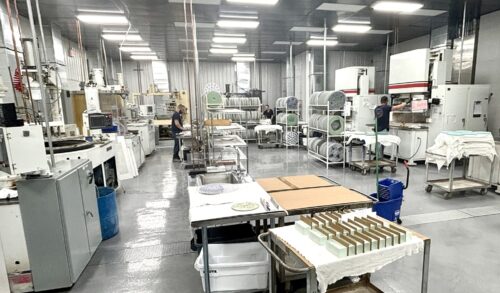
Unmatched Glass Polishing Capabilities
With decades of industry experience and advanced manufacturing capabilities, Swift Glass has the tools and expertise to provide the ideal glass finish for all your fabrication needs. We use various polishing methods to achieve superior craftsmanship and precision with the tightest tolerances for diverse applications.
Diverse Polishing Processes
Swift Glass offers a variety of polishing processes to achieve exceptional surface quality:
- Precision grinding
- Blanchard grinding
- Surface grinding
- Contour grinding
- Optical grinding
We offer cylindrical and edge grinding as secondary polishing processes.
Finished products meet tight tolerances for installation and strict scratch-dig specifications for demanding military and small optics applications.
Serving a Myriad of Industries
Glass polishing enables glass components to meet specific standards and function reliably in a variety of industries. At Swift Glass, we can handle various glass types to fulfill the challenging requirements of the following industries:
Precision and Control
Dimensional accuracy and smooth surfaces are essential to the functionality of glass products. Our polishing machinery is capable of flared edges, step grinding, beveling, chamfering, radiuses, and more, with a parallel and perpendicular tolerance of ±0.0005”. As a result, our customers benefit from safer handling and chip-free installations.
Technology Meets Expertise
Glass polishing requires a combination of extensive operator knowledge and advanced machinery for optimal results. Our advanced CNC operations can be combined with manual techniques to add dimensional details with accuracy and efficiency.
Fully Equipped Polishing Center
The recent expansion of our polishing center enhances our overall glass fabrication capabilities. The added space and new tools will help us take on larger, more complex projects and speed up turnaround times. Our new polishing center now features greater optics and polishing capabilities to better serve our customers’ needs.
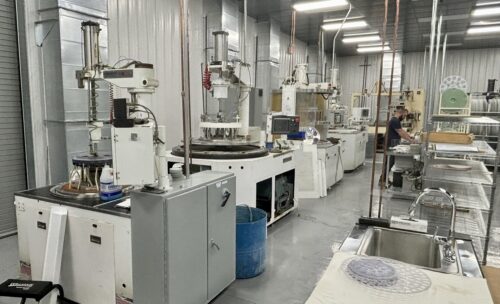
Elevate Your Project with Superior Polishing: Contact Our Glass Specialists
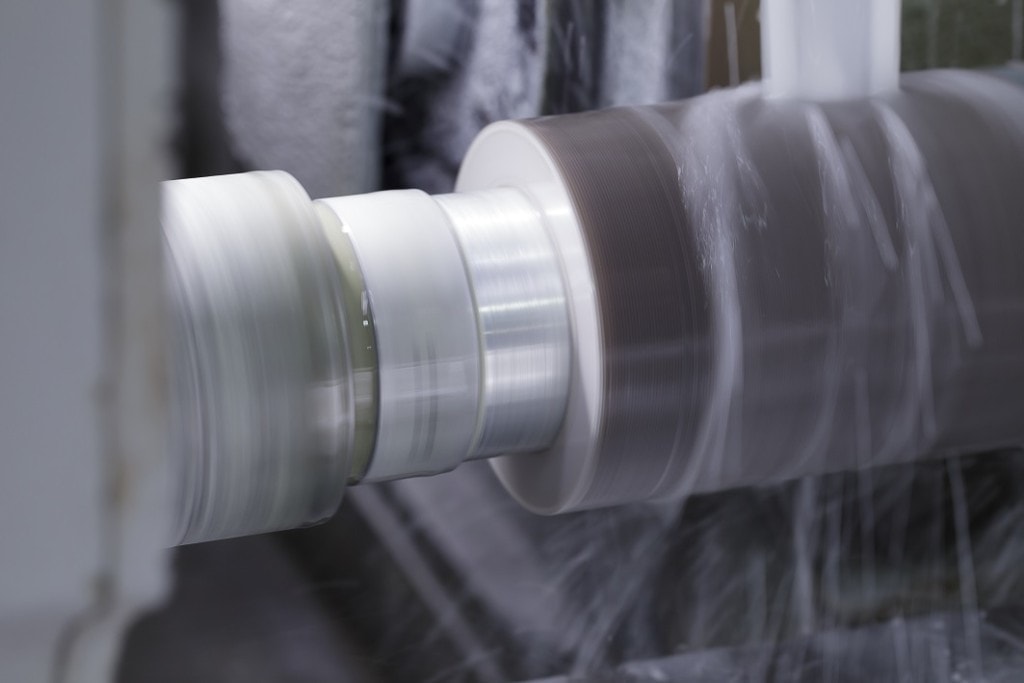
At Swift Glass, our expanded manufacturing capabilities and industry expertise enable us to meet a range of glass polishing specifications with superior results. We stock an extensive range of materials and utilize top-of-the-line machinery to respond quickly to our customers’ needs with outstanding craftsmanship. Contact us to learn more about our polishing services, or request a free quote on your next project.
Related Glass Polishing & Finishing Content
Light-emitting diodes (LEDs) produce light through a semiconductor. Semiconductors create visible light when a current causes electrons to transfer between one atom to an atom missing an electron. Light photons illuminate the LED as energy is released. The lights illuminate everything from automobile dashboards to athletic stadiums and can carry short-range optical signals for remote controls and telecommunications. We will discuss the LED fabrication process, the benefits of LED lighting,and choosing an LED glass panel to make your LED installation project a success.
LED Lighting & Its Benefits
LED lighting reduces energy consumption by up to 90% compared to standard bulbs, and reaches an average lifespan of 50,000 hours, or 40 times longer than standard bulbs. The diode of the LED is encased in an epoxy resin, providing improved durability over the filaments of incandescent lights. LEDs can resist vibrations, impacts, and shocks. They are also ideal lighting solutions in extremely high or low temperatures.

LED lights provide the following benefits:
- Low-voltage operation
- Instant illumination
- Design versatility
- UV and heat-free illumination
- Perform in harsh conditions
What Materials Go Into an LED?
Diodes in LED lighting consist of semiconductor layers measuring 0.5 microns or less. Each layer alternates between an excess and a deficit of electrons, allowing the electrons to pass between the layers to create light energy.
Manufacturers can manipulate the electron density through impurities called dopants in the semiconductor. Impurities in higher densities allow the crystalline structure within the semiconductor to conduct electricity. LED manufacturers prefer gallium arsenide phosphide (GaAsP), gallium phosphide (GaP), and gallium arsenide (GaAs) semiconductors to create distinct LED light colors. The impurities are intentionally added during the doping process to enhance the lighting.
Impurities or dopants include:
- Tellurium
- Germanium
- Silicon
- Nitrogen
- Zinc
Manufacturers attach wires to the semiconductor using a silver or gold compound to chemically bond the conductor to the surface and allow an electrical current to run through it. An epoxy resin encasing the LED allows manufacturers to change the optical properties and appearance of the LED. They can scatter, pinpoint, or shape the light and tint the plastic for more color variation.
How is LED Lighting Made?
LED lighting is made in the following four steps:
- Making Semiconductor Wafers: Phosphor, arsenic, and/or gallium are combined in a pressure- and temperature-controlled chamber. The liquefied materials are deposited on a rod to create an ingot. Wafers are sliced from the ingot, smoothed, and dipped in a solution to remove contaminants.
- Adding Additional Layers: Micron thick layers of crystal and dopants are added to the wafer using the liquid phase epitaxy (LPE) process, where crystal layers are grown by depositing molten GaAsp mixed with dopants on the wafer. Dopants can also be added in a high-temperature furnace containing gaseous dopants.
- Adding Metal Contacts: A photoresist compound is deposited on the wafer as it spins to create a predetermined pattern on its surface. The compound hardens at temperatures of around 215 °F and the wafer is exposed to UV light, creating a duplicate pattern on the photoresist. The exposed areas are filled by evaporating contact metal on the wafer in a high-temperature vacuum-sealed chamber. The LED is placed in a furnace with an inert hydrogen or nitrogen atmosphere and heated to bond the metal to the wafer surface. The wafers are snapped on a crystal plane or sawed with a diamond-tipped saw to create up to 6000 dies.
- Mounting: The dies are mounted to a package, and the back of the die receives a metal coating to form an electrical contact. The assembly is sealed in molded epoxy to form the desired shape.
Choosing the Right Glass for LED Lighting
Facilities like indoor farms, stadiums, warehouses, and commercial buildings demand glass panels for LED lighting parts. At Swift Glass, we have manufactured glass panels for the leading LED installers, offering thermal tempering for high-strength glass and specialty glass. Swift Glass is the oldest US-based tempered glass supplier. We offer various machining services and materials to deliver ideal LED glass solutions, including:
- A range of options, including patterned, float, and Borosilicate glass
- High-volume CNC cutting capabilities
- Edge polishing
- Chemical strengthening
- Hole drilling
Swift Glass: Your Partner for LED Lighting and Glass Solutions
Swift Glass is a national leader in manufacturing lighting glass and LED glass panels. We have more than 80 years of experience in the industry and are trusted by the nation’s largest LED installers. Rely on our various capabilities, including thermal tempering to increase glass strength, specialty glass, and machining services. Swift Glass is your superior partner for commercial LED lighting and glass solutions. Visit our lighting applications page or contact us to learn more about our LED lighting systems and request a quote today to partner with Swift Glass.
When choosing a solar panel, people often consider elements such as the solar PV panel’s power and overall efficiency. However, they may not consider how the type of solar panel glass influences performance. The glass also plays a key role in protecting the panel’s photovoltaic cells against environmental factors.
It’s important not to overlook solar panel glass when looking for the ideal solar panel model. Here we’ll go over what options to look for and what they can do for your solar panels.
The Function of Solar Panel Glass
Solar panel glass performs a few main functions for solar panels, including: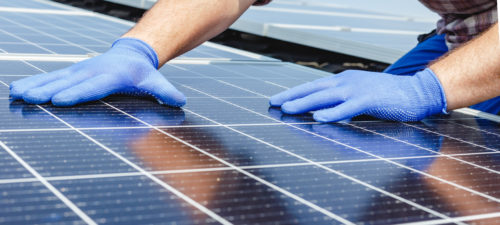
- Protection from damage — Tempered solar panel glass serves as a protective layer for solar panels, preventing environmental factors like vapors, water, and dirt from damaging the photovoltaic cells. Tempered solar panel glass also provides high strength, excellent transmissivity, and low reflection.
- Durability and safety — Tempered glass offers up to four times more strength than standard glass. This strength is critical as the solar panel’s front sheet requires lasting protection against the elements. Thanks to the thermal and chemical processes that produce tempered glass, it is also known as toughened or safety glass. Tempered glass is safer to use because it shatters into many smaller pieces when broken, reducing the probability of accidental injury.
- Weight — Glass must be of a certain weight for solar panels. The industry standard weight for a 3.2 mm thick solar panel glass is around 20 kg. Tempered glass can provide this minimum weight, avoiding the dangers of cheap, lightweight solar panel glass.
Types of Solar Panel Glass
Solar panel glass may consist of two main types: thin-film or crystalline. Both have distinct features to keep in mind.
- Thin-Film — Thin-film glass is lightweight, cost-effective, and easy to install. They are made of standard, non-tempered glass and can be as thin as 2.5 mm. Thin-film solar panels are lightweight because the glass encloses the panel without a frame. They require the most space and have the lowest efficiency out of all the solar panel glass options.
- Crystalline — Solar panels made with crystalline glass tend to have a thickness of 3 to 4 mm, which adds more stability. This glass has a unique rough surface, which enables the glass to bond well with the panel’s EVA film for lamination purposes. Smooth glass can lead to gradual delamination. There are two subtypes of crystalline glass: monocrystalline and polycrystalline. Both of these crystalline panels require a fabrication method that involves producing silicon crystals that are cut into thinner wafers for use in solar panel glass.
- Monocrystalline — These panels feature a sleek look and optimal efficiency, but they’re slightly more expensive than polycrystalline glass.
- Polycrystalline — These are less expensive than their monocrystalline counterparts, at the cost of reduced visual appeal and efficiency.
While some applications may call for cheaper glass panels, delamination and inadequate protection could reduce the longevity of your solar panels. Instead, opt for tempered glass with IEC61215, IEC61730, and UL1307 certification, which indicate that the panel has held up in safety and quality tests.
Solar Panels from Swift Glass
Swift Glass provides the best products available if you require high-quality solar panel glass for your solar assembly. Our selection includes Optiwhite and Starphire glass, both of which are low-iron glasses for solar applications.
Your Partner for Quality Solar Panel Glass
At Swift Glass, we offer reliable solar panel glass materials, with manufacturing capabilities including bending, CNC machining, thermal tempering, waterjet cutting, and more depending on customer needs. We have worked with top glass manufacturers, including GE, Corning, Auer, and Schott. Our company is ITAR registered and ISO 9001:2015 certified, and we pride ourselves on being a global leader in fabricating quality glass components.
To find out more about our solar panel glass fabrication capabilities, contact us or request a quote today.
Parallelism as a parameter plays a crucial role in glass fabrication. As it pertains to glass, the back and front planes of a glass part would achieve parallelism if the space between the planes remained the same so that they run alongside each other but never touch. However, parallelism in actuality is not perfectly possible for glass parts, which is why a parallelism conversion tool or calculator can help measure accuracy for setting any necessary limits.
Defining Glass Parallelism
Glass parallelism, also termed glass wedge, can be determined through various measurements, including transmitted wavefront error (TWE), total thickness variation (TTV), and arcs (minutes and seconds). TWE is the amount of deviation in degrees observed in a wavefront due to beam transmission through an optical device. Parallelism, energy, and irregularity can all directly affect the total wavefront error.
TTV is the value of the difference from the maximum to minimum thickness values over a part’s clear aperture. An interferometer and a scan pattern can help define the value to within 0.1µm and therefore successfully manage a thickness variation of less than 1µm.
An arcminute is an angular measurement standard unit equivalent to 1/60 of a single degree while an arcsecond is equal to 1/60 of 1 arcminute, or 1/3600 degrees of a circle. Both minutes and seconds of arcs can translate, in degrees, to the amount that they deviate from full parallelism. Parallelism calculators can help you determine the definition of glass parallelism in surfaces to get an accurate measurement, which you can use to develop optical wedges.
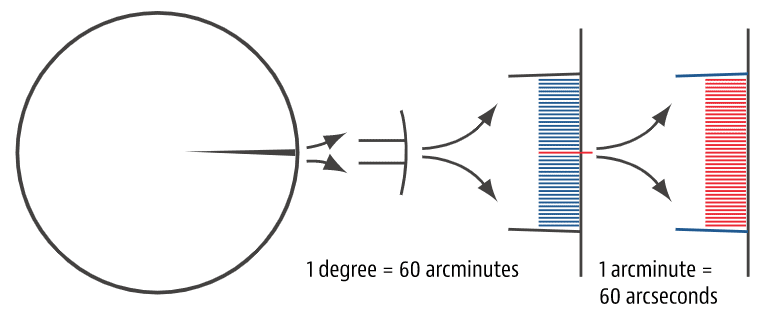
Applications for Optical Wedges
An optical wedge is fabricated to possess a minimal angle between two glass planes or surfaces and refract or deflect light at that predetermined angle when it hits the wedge surface. The angle could represent only a fraction of a degree, approaching true glass parallelism, to as much as a 3° angle. Even though high-precision optics are usually lapped and polished to achieve near-perfect parallelism, most will still have a slight optical wedge that measures in seconds or minutes of arc.
Optical wedges come in different shapes and sizes, have different tolerances or coatings, and are mainly designed to change the direction of light and prevent reflections. Many industries have adopted optical wedges for applications such as:
- Beam steering
- Beam shaping
- Machine vision
- Telescopes
Optical Glass From Swift Glass
At Swift Glass, we provide comprehensive, precise optical glass fabrication services for projects that require large production runs in little time, without sacrificing quality as an ISO- and ITAR-certified company. Optimal performance is key in optical glass parts like lenses and optical windows, so we carefully consider the chemical and mechanical properties of the glass in addition to the optical factors like surface flatness, quality, and finish.
Swift Glass focuses on the proper levels of glass density, transparency, and purity. Our laser and imaging systems allow us to offer scratch-dig specifications to 40-20 in a variety of sizes, and in some specific instances, a scratch-dig of 20-10 is achievable. We also offer a selection of materials and color filters for customization.
Swift Glass has a newly created parallelism calculator to help with the conversion of degrees to arcminutes and arcseconds to best serve our customers. To learn more about our capabilities for optical glass or this conversion tool, contact us today or request a quote.
Light has different properties that affect how we visualize objects. When waves encounter various barriers and mediums, like water, steel, or glass, they behave in different ways. Here, the team at Swift Glass shares the unique behaviors of light on glass.
Properties of Light
Light is a form of energy and part of a wider spectrum of electromagnetic radiation from the sun. Wavelengths tell us what type of light we’re dealing with. For example, microwaves and radio waves are on the long side of the spectrum, while UV rays and X-rays are much shorter.
When light hits an object, it may be absorbed, reflected, or refracted, depending on the type and shape of the material it hits. This is a key consideration when designing lenses, which are optical devices that use refraction to focus or disperse light. When creating lenses for microscopes, cameras, eyeglasses, and more, engineers have to consider the properties of the material and how light will interact with it.
Behaviors of Light
Light waves and particles interact with glass and other materials in different ways, depending on the type of light and the structure of the material: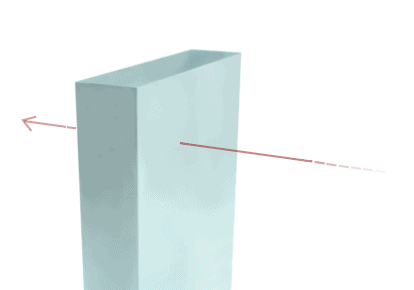
- Transmission: The light passes directly through without being reflected, scattered, or absorbed. A transparent material, like a typical window, allows transmission of almost all light. An opaque material allows no transmission at all, and a translucent material, like a shower door, allows some transmission—however, that light gets scattered, which results in an unclear picture of what’s behind that translucent glass.
- Reflection: All types of waves, including light and sound, reflect off certain materials. When it comes to sound, certain animals, like bats, use that reflection (echoes) to find their way around. When it comes to light, smooth surfaces reflect it best: the perfect smoothness of a mirror gives us a clear reflected image, while the moving surface of the water gives us a blurry reflection. Reflection is also how we see color: a purple object, for example, is absorbing most of the wavelengths and reflecting the one we see as purple.
- Refraction: Light travels at different speeds through different mediums, and passing from one medium to another changes the direction of the light (refraction) and typically causes it to change speed. The bending of light through a convex lens can make objects appear larger.
- Diffraction: This is the bending and the spreading of the light waves—it’s what causes rainbows! You can also diffract light on purpose using a spectrometer to separate the wavelengths. This is useful in scientific applications to measure specific types of light.
- Absorption: When light photons hit the atoms and molecules that make up the highway, for example, those atoms vibrate and create heat. Dark materials (like a blackhighway) absorb more than light-colored materials (like the gray sidewalk)—which is why you may tend to prefer wearing a white shirt instead of a black shirt on a hot summer day.
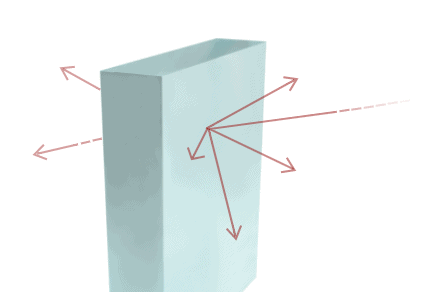
- Scattering: This is when light bounces off the glass in multiple directions. There can be a little scattering or a lot, depending on which type of wave is scattering and what type of object it’s scattering off and through. This is why the sky is blue: nitrogen and oxygen scatter the short blue and violet waves, while the longer red and yellow waves pass right through. Violet waves are actually shorter and scatter more than the blue ones, but our eyes are more sensitive to blue, so that’s what we see when we look up on a clear day.
The way light behaves is fascinating, which is what makes the optical industry so exciting. Learn more about light and its properties and behaviors, or contact us for more information about custom glass fabrication. Swift Glass is a worldwide leader in high-quality glass manufacturing, and our experienced team works to ensure we meet your specifications and expectations as well as industry standards. We work on projects in a range of industries and applications. Request a quote today.
At Swift Glass, we specialize in the fabrication of quality glass components. We offer a range of fabrication capabilities to ensure the parts and products we deliver fully meet our customers’ specifications and standards. For example, our machining and surface finishing services allow us to carefully alter the shape and/or surface of very small to very large glass materials.
Two commonly utilized machining and surface finishing processes are microblasting and sandblasting. While these processes might seem similar at first glance, they use different tools to achieve different results. Below, we provide an overview of both processes and highlight some of the key differences between them.
What Is Microblasting?
Microblasting—also referred to as microblast machining or micro-abrasive blasting—is a fabrication process that utilizes fine abrasive media and small nozzles to generate an accurate, precise, and controllable abrasive jet. The jet can be used to target and remove material (on the micron level) from a workpiece for various purposes. For example, it can cut glass into various shapes and sizes, create small structural elements (e.g., holes), produce fine surface textures, or clean/strip the workpiece surface in preparation for subsequent processes.
Due to its versatility, microblasting finds application in many industries. For example: 
- In the medical industry, it is used to remove excess or residual material from manufacturing tools (e.g., molds) and manufactured components (e.g., implants).
- In the aerospace industry, it is used to clean off residues from components such as circuit boards and create surface textures on components such as connectors and HUD optics.
- In the electronics industry, it is used on electronic components to cut holes for easier assembly and create textures for improved bond adhesion.
What Is Sandblasting?
While the sandblasting process is based on similar principles as the microblasting process—i.e., using compressed air to force abrasive media out of a nozzle at high pressures and speeds—it is generally used for different reasons. When the abrasive media hits the glass, it produces microscope scratches. These scratches are used to achieve a specific texture for functional or aesthetic purposes, depending on the intended application of the final component.
In contrast to microblasting, sandblasting is typically reserved for cutting and texturing applications. Typical uses include:
- Carved glass components
- Frosted glass components
Microblasting vs. Sandblasting
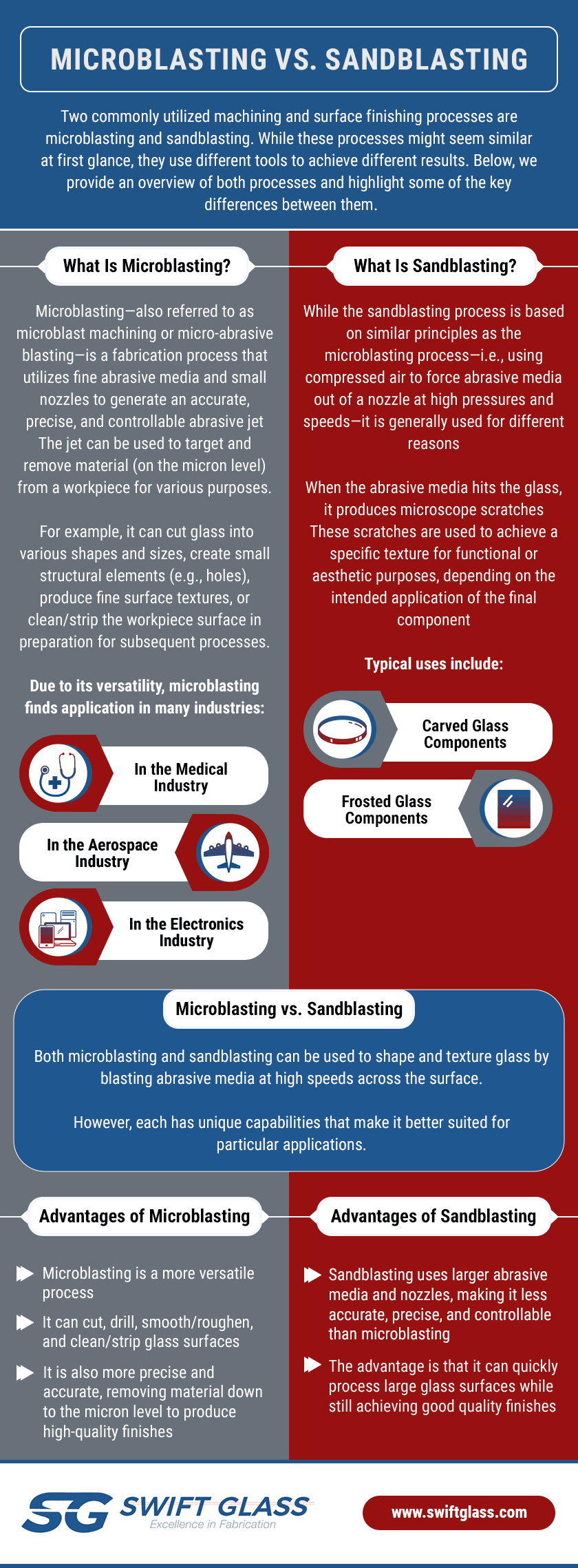
Click to Enlarge
Both microblasting and sandblasting can be used to shape and texture glass by blasting abrasive media at high speeds across the surface. However, each has unique capabilities that make it better suited for particular applications.
Advantages of Microblasting
Microblasting is a more versatile process. It can cut, drill, smooth/roughen, and clean/strip glass surfaces. It is also more precise and accurate, removing material down to the micron level to produce high-quality finishes.
Advantages of Sandblasting
Sandblasting uses larger abrasive media and nozzles, making it less accurate, precise, and controllable than microblasting. The advantage is that it can quickly process large glass surfaces while still achieving good quality finishes.
Microblasting Services at Swift Glass
Want to learn more about microblasting and sandblasting? Ask the glass fabrication experts at Swift Glass! We maintain advanced microblasting capabilities as well as sandblasting capabilities to produce quality glass components for our customers. If you have a question or concern about either process, we can answer or address it. For all of your glass machining and/or finishing needs, request a quote to discuss your specifications and standards.
Understanding the behavior of light can be an important factor when determining which glass materials to use for your manufacturing process. When light passes through a substance, it decreases in velocity. This is manifested by an increase in the substance’s refractive index. Much can be learned about the optical properties of a glass material by looking at its refractive index.
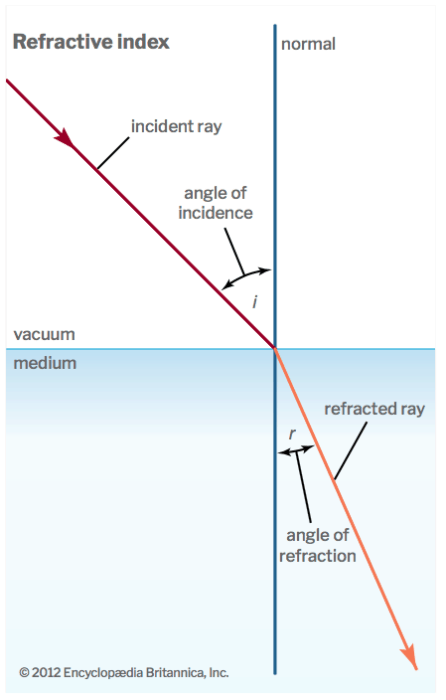 Refractive index is useful for various reasons. For one thing, it can be used to calculate the focusing power of lenses and the dispersive power of prisms. It can also be used in estimating the thermophysical properties of hydrocarbons and petroleum mixtures.
Refractive index is useful for various reasons. For one thing, it can be used to calculate the focusing power of lenses and the dispersive power of prisms. It can also be used in estimating the thermophysical properties of hydrocarbons and petroleum mixtures.
What is the Refractive Index?
Also commonly referred to as the index of refraction, the refractive index, n, measures a ray of light as it travels from one medium to another. As it begins to travel through a material, the interaction between electrons and photons reduces the speed of light. As the density of the electrons increase, the velocity of light becomes slower. This is why light moves at its highest possible speed in a vacuum, where no electrons hamper its speed.
Knowing the refractive index – among other thermal, chemical and physical properties – helps ensure that the glass material you’re considering for your application is suitable for its intended use.
Determining the Refractive Index of a Material
The ratio between the speed of light in a vacuum and the lower velocity of the light as it travels through a given material enables us to determine the refractive index of a given material.
In addition, the amounts of transmitted and reflected light will determine not only the refractive index of a glass material, but also its angle of refraction. This is because light gets transmitted and reflected as light rays pass through the surface of a glass material.
The light’s transmission angle can be calculated using Snell’s law:
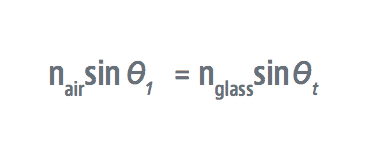
The discrepancy between the light’s transmission and the incidence angle becomes bigger as the index of refraction becomes larger. When this occurs, there is a change in the existing refractive index between the glass and the surrounding medium.
When Θi = 0°, the amount of reflected light can be determined using the following formula:

Lastly, the intensity of light is reduced by an average of 4% due to lost reflection from the surface of most glass materials with a 1.5 refractive index.
A change in the index of refraction due to changes in wavelength is known as chromatic dispersion.
Conclusion
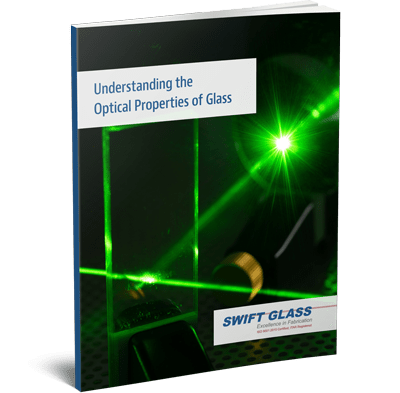 Swift Glass has been providing custom glass manufacturing services for nearly a century, and providing high-quality solutions to OEMs is one of our core principles. Our experience and dedication to customer service enables us to understand the intricate needs of our customers, and to exceed their basic needs.
Swift Glass has been providing custom glass manufacturing services for nearly a century, and providing high-quality solutions to OEMs is one of our core principles. Our experience and dedication to customer service enables us to understand the intricate needs of our customers, and to exceed their basic needs.
An ITAR registered, ISO 9001:2015 certified company, Swift Glass is a privately-owned global leader in the quality fabricated glass parts. Swift Glass offers assistance in craftsmanship, material selection, and manufacturing of custom solutions, and design, while guaranteeing high quality and precision.
To learn more about the optical properties of glass, download our latest eBook, Understanding the Optical Properties of Glass today!

Swift Glass is excited to announce that we’ll once again be attending the annual SPIE Photonics West Conference and Exhibition, at the Moscone Center in San Francisco from January 28 to February 2.
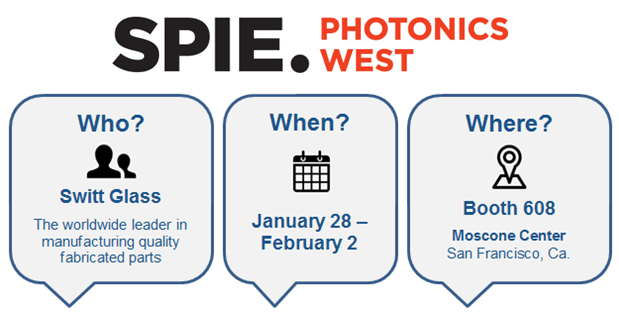
Hosted by the International Society for Optical Engineering (SPIE), Photonics West has been the world’s largest multidisciplinary event for biomedical and medical photonic technologies for over two decades. Attended by over 20,000 people, this exhibition draws industry leaders from across the country to view new technologies, hear educational speakers, and network with others in the field.
State-of-the-art medical devices and systems, the Internet of things, smart manufacturing and “Industry 4.0” autonomous vehicles, communications equipment, new scientific research, and various displays will all be on view at the photonics exhibition. Attendees will have the chance to go to technical and networking events, as well as professional development seminars and student events. Various workshops will also be offered, with topics including laser applications, optomechanics, semiconductor lasers and LEDs, and biomedical spectroscopy, miscopy, and imaging.
We’ll be set up in Booth #608, displaying various types of display glass, as well as large chemically strengthened rectangular glass and other samples of our chemically strengthened glass. We’re looking forward to speaking with other optics conference attendees and showcasing our unique product line. We hope to see you there!
As an ISO-certified and ITAR-registered company, Swift Glass is committed to quality in everything we do. Our custom glass manufacturing capabilities include chemical strengthening, waterjet cutting, edge grinding, thermal tempering, surface lapping, CNC machining, polishing, drilling, and optical glass fabrication.
To learn more about this exciting glass manufacturing conference, reach out to us today. And, for more information about our diverse service offerings, visit our website.
Glass Solutions for Extreme Environments
Glass is among the world’s most sophisticated materials. Specialty glass can withstand high pressure, extreme heat, and extraordinary environments.
There are two primary methods for strengthening glass: chemical strengthening and thermal tempering. Both of these processes alter the outer surface of the glass, causing it to have a higher compression than the interior glass, which is in a state of tension. Depending upon the specific application, each process offers unique advantages for a material’s final makeup.
Chemical Strengthening
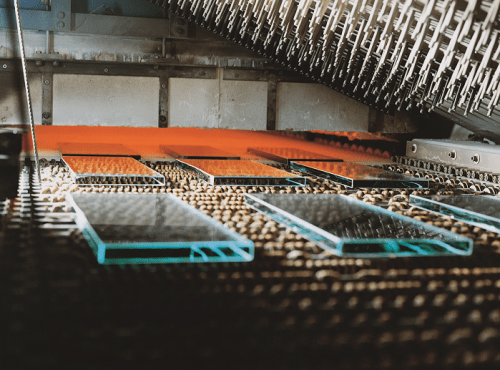 Also known as ion exchange, chemical strengthening treats glass by submerging it in a molten potassium salt bath, causing sodium ions in the glass to be replaced by potassium ions from the bath. The potassium ions, which are larger than the sodium ions, squeeze themselves into the gaps left by the smaller sodium ions when migrating to the potassium solution. The surface of the glass is then in a state of compression while the core is in compensating tension.
Also known as ion exchange, chemical strengthening treats glass by submerging it in a molten potassium salt bath, causing sodium ions in the glass to be replaced by potassium ions from the bath. The potassium ions, which are larger than the sodium ions, squeeze themselves into the gaps left by the smaller sodium ions when migrating to the potassium solution. The surface of the glass is then in a state of compression while the core is in compensating tension.
The chemical composition of the bath can vary widely, allowing this process to be tailored to the material’s final application.
Chemical strengthening can create a high-performance glass with no notable distortion and a very shallow surface layer of strengthened, alkali-rich material. The added strength of this specialized glass makes it ideal not only for harsh environments but also for high-performance applications in conductors, semiconductors, energy, medicine, and more. Chemical Strengthening can be performed on much thinner glass than heat tempering.
Glass Tempering
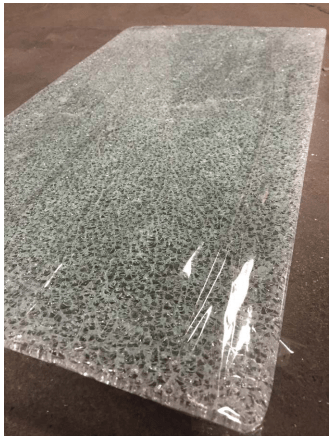 Tempered glass undergoes an intense heating process immediately followed by rapid cooling. This extreme temperature shift causes the glass surface and edges to compress, creating an extremely tough outer surface with a tensioned glass core.
Tempered glass undergoes an intense heating process immediately followed by rapid cooling. This extreme temperature shift causes the glass surface and edges to compress, creating an extremely tough outer surface with a tensioned glass core.
When broken, tempered glass breaks into small particles along circular edges, eliminating the risk of dangerous shards. This makes tempered glass an ideal choice for a wide range of applications, including:
- Industrial environments
- Safety glass (windshields, windows, and situations with exposure to projectiles)
- High-temperature environments and thermal stresses
- High-pressure applications
From aviation and aerospace to laboratories and industry to household items and fire safety, both chemically strengthened and thermally tempered glass offer countless solutions to daily safety and environmental challenges.
Glass Solutions from Swift Glass
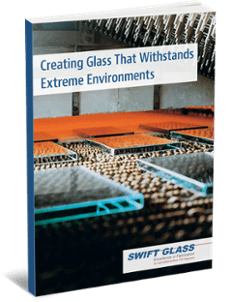 No matter the size or demands of your project, Swift Glass can help. Our specialists offer ultra-high pressure cold cutting, CNC machining, polishing, drilling, printing, and a host of other manufacturing capabilities to support both our chemical strengthening and thermal tempering services.
No matter the size or demands of your project, Swift Glass can help. Our specialists offer ultra-high pressure cold cutting, CNC machining, polishing, drilling, printing, and a host of other manufacturing capabilities to support both our chemical strengthening and thermal tempering services.
To learn more about high-performance glass that can withstand even the most difficult circumstances, download our new eBook, Creating Glass That Withstands Extreme Environments, or reach out to us today!












 Refractive index is useful for various reasons. For one thing, it can be used to calculate the focusing power of lenses and the dispersive power of prisms. It can also be used in estimating the thermophysical properties of hydrocarbons and petroleum mixtures.
Refractive index is useful for various reasons. For one thing, it can be used to calculate the focusing power of lenses and the dispersive power of prisms. It can also be used in estimating the thermophysical properties of hydrocarbons and petroleum mixtures.




 Also known as ion exchange, chemical strengthening treats glass by submerging it in a molten potassium salt bath, causing sodium ions in the glass to be replaced by potassium ions from the bath. The potassium ions, which are larger than the sodium ions, squeeze themselves into the gaps left by the smaller sodium ions when migrating to the potassium solution. The surface of the glass is then in a state of compression while the core is in compensating tension.
Also known as ion exchange, chemical strengthening treats glass by submerging it in a molten potassium salt bath, causing sodium ions in the glass to be replaced by potassium ions from the bath. The potassium ions, which are larger than the sodium ions, squeeze themselves into the gaps left by the smaller sodium ions when migrating to the potassium solution. The surface of the glass is then in a state of compression while the core is in compensating tension.


